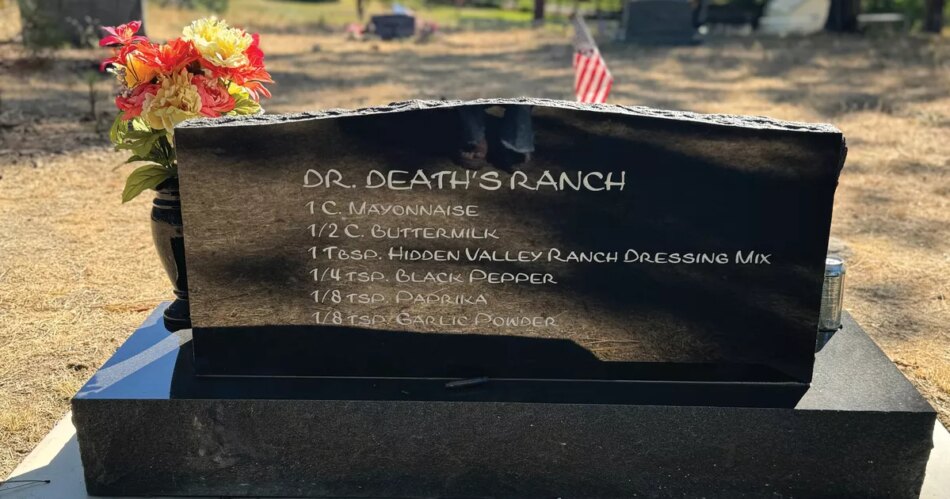The comfort of a bowl of slow-simmered chicken soup.
A whiff of cinnamon from snickerdoodles just out of the oven.
The tang of homemade ranch dip on a crunchy chip.
Food is the gateway to memory. A bite of rich chocolate Texas sheet cake can evoke your favorite aunt, who brought that dessert to every family gathering and church potluck.
A new cookbook features recipes for all of the above and more, sourced from surprising locations – cemeteries around the globe.
“To Die For: A Cookbook of Gravestone Recipes” (HarperCollins, 2025) features 40 recipes, along with interviews and full-color photographs. What began during author Rosie Grant’s digital archives internship at the Congressional Cemetery in Washington, D.C., became a viral sensation when she started cooking real gravestone recipes and sharing their stories via TikTok.
“I was finishing my master’s in library in information science at the University of Maryland and started a TikTok channel (@ghostlyarchive) about what it’s like to intern at a cemetery,” Grant said.
She came across other social media accounts that featured recipes carved on headstones.
“I love to cook and I love to eat, so I tried three of the recipes and posted them,” she said. “People started reaching out.”
The first recipe she tried came from Naomi Odessa Miller-Dawson’s grave in Brooklyn, New York. Miller-Dawson’s gravestone resembles an open book with her spritz cookie recipe etched in the stone.
While the monuments list ingredients, they don’t often include instructions. Thus, Grant didn’t realize that she needed a cookie press to make spritz cookies.
She laughed and said, “I made pretty much every recipe incorrectly! I now own multiple cookie presses.”
When she’d gathered 20 recipes, publishers expressed interest in a cookbook.
Eventually, Grant ended up with 40 “To Die For” recipes.
The author didn’t just make the recipe; she visited each cemetery featured in North America and photographed the gravestone. She interviewed family and friends of the deceased and often cooked with them, whether in person or via Zoom.
“I made spritz cookies with Naomi’s family,” she said. “They were so generous with their time!”
Gravestone recipes are rare, but the author discovered one right here in Spokane County.
You can find Marty Woolf’s recipe for ranch dip on his headstone at Saltese Cemetery in Greenacres.
An avid golfer, Woolf grew up in Spokane Valley. After graduating from dental school, he and his young family relocated to New Mexico to work alongside his brother and his best friend.
In 2022, he fell ill unexpectedly and died a few days later. His obituary in The Spokesman-Review read, “There are few people in this life that when you meet once, you never forget them. Marty was the sweetest husband, most loving father, and best friend to countless people.”
Grant contacted his sister-in-law to learn more about Woolf. She discovered his nickname was Dr. Death, and he loved to share recipes.
“Dr. Death’s Ranch was something he loved to make,” said Grant. “When I visited his grave, someone had left a can of Mountain Dew beside it.”
When staging the food pictures, photographer Jill Petracek took care to add subtle nods about the deceased. In the photo of the ranch dip, a glass of Mountain Dew sits nearby.
Surprisingly, a few of the recipes in the book came from the living.
“These women were preplanning,” Grant said.
Before Peggy Neal’s husband died, they prepared their headstones together. As an avid hunter, his side featured game animals.
“What do I want to be remembered for?” Neal thought. “Well, I am darn proud of my cookie recipe!”
So, the recipe for Peg’s sugar cookies was etched into the marker, and the book features a photo of a smiling Peg next to it.
“I got to cook with Peggy in Arkansas,” Grant said.
Likewise, Cindy Clark Newby’s recipe for No-Bake Cookies is on her headstone.
“I thought about what my family would feel when they visited my grave,” she said. “I pictured them laughing when they saw I’d put my cookie recipe on there.”
From a chocolate chip cookie recipe on a book-shaped headstone with “Cookie Book” on the spine, to a marker featuring a handwritten chicken soup recipe, Grant uncovered the stories ordinary people remembered for the way they fed and gave to others.
She urges readers to document their own recipes and food histories and included resources to assist them.
Traveling to cemeteries throughout the country and recreating cherished recipes allowed Grant to understand the role of food in preserving memories, as well as fostering a deep appreciation for the loving legacies etched in stone.
“It’s a testament to who these people were in life – generous and giving.”
You can reach Cindy Hval at dchval@juno.com







